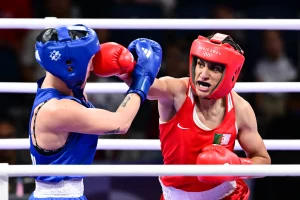2 Chapter 2
CHAPTER 2-Playing With Gender
PART 1
Unseen Battles: Gender and Sports History

One surprising detail was the existence of “nude parades” before 1968, where female athletes were physically inspected to verify their sex. It’s shocking to learn that such invasive and dehumanizing practices were once standard. Additionally, the fact that women only made up 2% of athletes in the first modern Olympics and that it took until 2012 for women to compete in every Olympic sport highlights the long history of gender discrimination in athletics. The idea that sports could have been integrated rather than sex-segregated is also an interesting perspective that challenges how we think about competition today.
“Transgender Triumphs and Trials”
A significant addition to this timeline would be the 2018 case of Caster Semenya’s legal battle against the IAAF, where the Court of Arbitration for Sport upheld the IAAF’s rules that required Semenya to lower her testosterone levels in order to compete in women’s events. This case is important because it highlighted the intersection of gender, biology, and human rights, sparking a global conversation about the fairness of regulations targeting athletes based on natural variations.
Bound by Gender
The gendering of sport has not personally been a major constraint on my involvement, but I can see how it could affect others. Growing up, I never faced direct pressure to stick to “female” sports, but I’ve witnessed many friends feel discouraged from pursuing sports like football or basketball due to societal expectations that those were for boys. In my case, I was encouraged to play tennis, a sport that is often marketed toward women, which aligned with the cultural assumptions about what’s appropriate for women to do. However, if I were interested in a more traditionally “male” sport, I might have faced resistance or felt the need to prove myself in ways that wouldn’t have been necessary in a gender-neutral environment. The way sport is gendered often reinforces the idea that certain activities are “not for you” based solely on your gender, which limits options for anyone who doesn’t fit those norms.
Gendered Fields

In my experience, gender coding in sports is very much alive, especially at the professional level, even though many sports are technically unisex. Growing up, I noticed how certain sports seemed to have a “gender” attached to them. For instance, soccer and basketball were always seen as “boys’ sports” in my community, while gymnastics and cheerleading were marketed as “for girls.” These assumptions shaped how I viewed these sports, whether I felt encouraged to participate or if I even considered them an option.
When I think about professional sports, it’s still clear that certain athletes face different expectations. For example, women in tennis, like Serena Williams, are often measured not just by their performance but also by how feminine they appear in their attire and their overall presentation. In contrast, male athletes in sports like football or basketball are expected to be tough and masculine, with little concern for their appearance. Even with sports like swimming or track, which have no inherent gender bias, the way they are marketed can still reinforce gender distinctions.
Additionally, I think of sports like mixed martial arts (MMA), where the rise of female fighters like Ronda Rousey has slowly started to shift perceptions. However, the contrast with male fighters remains stark in terms of audience expectations and media portrayal. It shows that while the sports themselves might not require a gender distinction, society’s view of them certainly does, shaping the experience of athletes and fans alike.
This gendering in sports, whether in competition or public perception reflects a broader societal tendency to separate and label. Despite the strides we’ve made in some areas, it’s clear that sports are still often viewed through the lens of the gender binary.
“Is the Debate Around Trans Women in Sports Exaggerated?”
I agree with Leah Thomas’s statement to a large extent. The idea that trans women competing in women’s sports threatens the integrity of these sports is, in my view, overstated. First, as she points out, trans women represent a very small minority of athletes. The sheer numbers don’t seem to support the narrative that trans women are dominating women’s sports.
For example, in 2016, the NCAA implemented rules allowing transgender athletes to compete in accordance with their gender identity. Despite this, we have not seen a massive shift or dominance by trans women in most sports. To my knowledge, the number of trans women who are excelling at an elite level in women’s sports remains limited.
One example of this is the media focus on high-profile cases like Lia Thomas’s participation in collegiate swimming. While her case garnered a lot of attention, it was a single example among many athletes. The broader reality is that only a tiny fraction of trans athletes are competing at elite levels, so the narrative of “domination” feels exaggerated.
Moreover, many female athletes themselves seem to support the inclusion of trans women in sports, provided there are fair and consistent policies in place to ensure that competition remains equitable. Take for instance the conversations around the International Olympic Committee’s guidelines for trans athletes, which include hormone level requirements to ensure fairness in competition.
Ultimately, I believe that focusing on the actual number of athletes and the structures already in place (like the NCAA’s rules and others like them) provides a more reasonable perspective than buying into the sensationalized narratives we often see in the media.
Class Activity: The Fairness of Sports – In Favor vs. Against
In Favor:
I agree with the idea that “sports, by design, are not fair” and that we often accept unfairness in sports. Elite sports, in particular, are full of inherent inequalities. Factors like genetics, socioeconomic status, access to coaching, facilities, and even luck can all influence an athlete’s success, making the playing field anything but even. For instance, a sprinter’s genetic makeup—such as muscle fiber composition—can make a world of difference in how fast they run, regardless of how much they train. Some people are naturally predisposed to excel in certain physical areas, and there’s not much that can be done to level that out.
Take the example of elite tennis. While the top players are certainly incredibly skilled, some have the advantage of growing up in environments where they can afford years of top-tier coaching, international travel, and access to the best training centers. For others, like those from less privileged backgrounds, that path might not even be a possibility, regardless of how talented they are. This is just one example of how systemic inequalities can affect fairness in elite sports.
Also, in many cases, sports don’t level out every aspect of competition. The advantage some athletes have from a young age, whether it’s in training, facilities, or simply natural talent, means that not all competition is perfectly fair. And yet, we often celebrate the excellence of those who rise to the top in spite of these inequalities, which speaks to how much we’ve accepted this inherent unfairness as part of the system.
In a way, sports are about maximizing the potential within whatever set of advantages an athlete has, rather than ensuring a perfectly level playing field.
When Robins argues that “the aims of transvestigating an Olympic athlete are not, in any meaningful sense, anything to do with sports, or fairness, or even with women (cis women, at least) as a social category,” she’s making a profound statement about the underlying motives behind this kind of public scrutiny. Essentially, she’s saying that the real issue isn’t fairness in sports or protecting cis women’s space in athletic competitions. Instead, the focus is intentionally misdirected—because the goal isn’t about the athlete, their abilities, or their gender in the traditional sense. It’s about transness, and specifically, about using the public exposure of transfemininity to provoke a broader cultural reckoning on trans women’s existence and legitimacy.
In other words, the spectacle of “transvestigating” athletes like Imane Khelif is a proxy for the bigger, more insidious battle over whether trans women are real women at all. The effort to “unmask” or question Khelif’s gender isn’t truly about her individual case; it’s about dredging up the broader, deeply ingrained fears and prejudices about trans women. It’s an excuse to publicly and collectively question the validity of trans women’s existence and to impose a set of rigid, exclusionary definitions of womanhood that harm all trans people, especially trans women.
For Robins, it’s clear that these debates, especially when played out in the court of public opinion, are rarely about the athletes themselves or about fairness in sport. Instead, they are part of a wider culture war about whether or not trans women should be allowed to occupy spaces in society where they are “seen” as women. And unfortunately, this battle is being fought at the expense of real people’s lives and futures.
Media Attributions
- man-vs-woman-gender-war-260nw-1477334693
- gendergame
- GettyImages-2164668423

